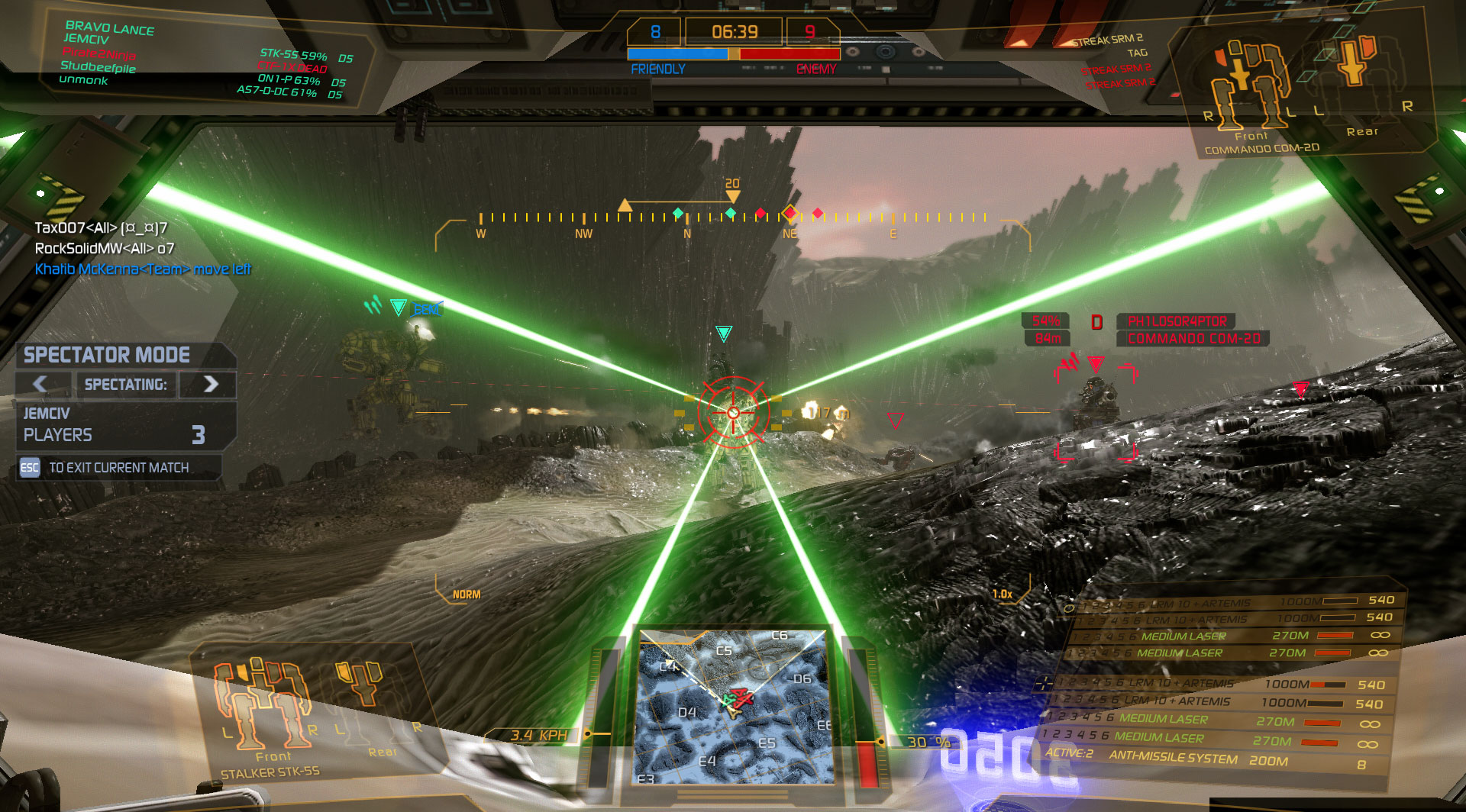Our Verdict
Slightly overpriced, but a more than worthy successor to one of PC gamings greatest franchises that nails the important part: combat.
PC Gamer's got your back
MechWarrior Online doesn't have melee combat, but it does have plenty in common with boxing. Both divide fighters into weight classes. Both test your pain tolerance against your damage output. In both, fighters target their opponents' injuries while twisting to protect their own wounds.
And “brawler,” appropriately, is the nickname given to mechs built to fight within 100 or 200 meters. Here, at close range, MechWarrior's resemblance to hand-to-hand combat is clearest: clumps of missiles hook into steel ribs, cockpits rattle like concussed skulls, assault mechs swing with every weapon until their arms fall off.
This fistfighty feel is what distinguishes MechWarrior Online's 12-on-12 team deathmatches from military FPSes and fellow vehicular shooters like World of Tanks and Hawken. Most of Piranha Games' time spent developing MWO has been dedicated to making that mech combat technically and mechanically sound, and it's left the game's balance in a great state--unlike boxing, a 25-ton scout can occasionally KO a 100-ton heavyweight. A wide variety of mech builds are viable and interesting, from sluggish, LRM-packed “missile boats” that rely on teammates to acquire targeting information for them, to fragile, agile pests like Locusts and Spiders.
"I love how much marksmanship MWO demands despite the size and generally lumbering speed of the titans you're piloting."
But Piranha's focus on perfecting MWO's combat before fleshing out other features has a drawback: even after emerging from beta, some aesthetic and secondary elements of the game like menus and UI remain rough. MWO's in-game command map is a vestigial feature that's clumsy to operate while under fire, and it remains practically ignored by players. More fundamentally, the presentation of customization (a core MechWarrior tenet) hasn't received the attention it deserves. The MechLab, the garage where mechs are bought and modified, doesn't display fullscreen. Data on weapons and armor in this space are poorly presented, with key stats like heat efficiency displayed in a way that's alienating to newcomers. Bizarrely, you can't compare stats side-by-side. Aesthetic customization, too, is crudely implemented, with paint colors and patterns organized as text lists rather than a visual palette.
Some of my complaints will be addressed in a planned “ UI 2.0 ” update to MWO, but in the meanwhile almost all of MWO's appeal hinges on its excellent combat. Inside the cockpit, intricate mechanics like modular damage, heat management, ammo detonation, and throttle delay work your reflexes and brain equally. Gauss rifle slugs, for example, are one of the only ammunition types that don't explode when their housing is destroyed. The gauss rifle itself, however, is volatile, and if you destroy one you'll deal extra damage unless your enemy installed a CASE explosion-containment module. But wait--that module is meaningless if they're running an XL engine, which unlike standard engines occupy all three torso segments. Imagine trying to exploit this knowledge as you're being cooked with lasers and you've got an idea of high-level MWO play.
What's a shame is how little energy Piranha has dedicated to explaining these nuances to newcomers. The most complex systems--like equipment that improves and disrupts missile targeting--aren't even mentioned in MWO's modest tutorial. Still, the core concepts are intuitive, and building a durable, straightforward mech doesn't take an engineering degree. I love how much marksmanship MWO demands despite the size and generally lumbering speed of the titans you're piloting--it takes skill, patience, and intuition to paint a scout mech with lasers as it's circle-strafing you at 120kph.
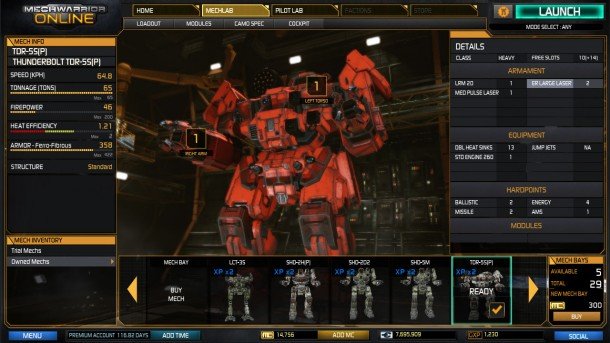
And as you tally more matches, you notice the way that mechs' inherent durability makes MWO one of the few shooters where you can savor the gradual destruction of your opponent. Mechs die hard; they erode. Sparks erupt from crippled legs, lasers blemish metal with molten heat, layers of armor peel away as paper-doll damage indicators turn from neutral to yellow to orange to red. Without sounding like a complete sadist, watching these signs of pain erupt from your robotic enemies is brain-tingling.
Keep up to date with the most important stories and the best deals, as picked by the PC Gamer team.
The relationship you develop with your mechs is MWO's other great aspect. Damage isn't persistent, but eventually you'll get your engine blown right out of your chest, retreat to the MechLab to rework your build, and then requeue to test your modifications. That gameplay loop of death, iteration, and success is special, as the control you have over your mech is what allows you to feel validated when a build works. It also creates opportunities to fall in love with different weight classes and weapons.
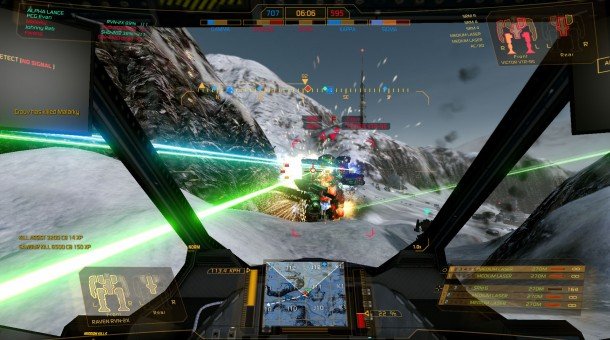
My main is an Orion “Protector” variant, a 75-ton heavy that I threw two ultra AC5s into. It's a medium-long range gunslinger that works best when it's holding down a corridor, punishing slower enemies who peek out of cover. When I take a loss, I switch to my 35-ton Raven, which can move at almost twice the speed. I don't get many kills with it, but MWO makes it unusually gratifying to play as a decoy. I get an XP reward for every enemy I spot for my teammates, but that's just extrinsic icing on the cake--the joy is in carefully timing my advance to make larger mechs turn and chase me, exposing their fragile rear armor to my teammates' guns. It's wonderful that every build takes slightly different skillsets to operate--my Raven relies on a great fight-or-flight intuition and map knowledge.
Of those nine maps (plus a couple sunless variations of them), I grin when I load into six of them. Terra Therma is a volcanic maze, a series of bottlenecks formed by high cliffs that stifle movement a little more than I'd like. Alpine Peaks is enormous, but barren and landmarkless in a way that makes it tough to memorize. I'd love to see a few more distinguishing landmarks in general--Crimson Strait has a rail tunnel that heavy mechs can sneak single-file through. Some backbreaking flanks and defenses happen at the mouth of this tunnel--if scouts don't let you know what's on the other side, your heavy mechs might find doom waiting for them at the end.
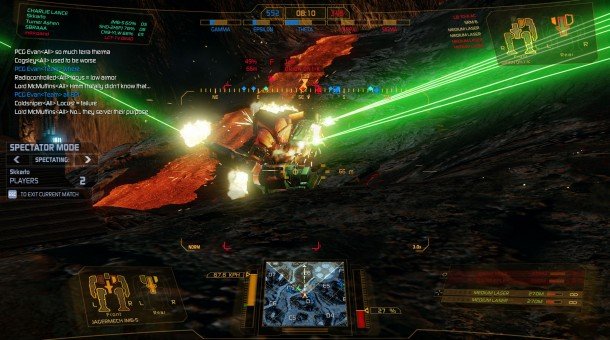
Canyon Network, Tourmaline Desert, and Caustic Valley, on the other hand, are spacious mixtures of open and dense. MWO also brings urban maps--about three of them--to MechWarrior for the first time, although the offices and apartment towers mostly amount to rectangular pylons--they don't deform or break and the streets are abandoned. Admittedly I wouldn't be out playing hopscotch if a mech fight broke out on my homeworld (or would I), but this does make cities feel more like thematic obstacles than immersive spaces.
MWO needs more mode variety to get better mileage out of these maps. There are just two: a five- capture point domination mode that's become less satisfying the more I've played, and a straightforward 12-on-12 brawl. Piranha mentioned a multi-stage “dropship” mode where each player would bring four mechs to the battlefield (that they'd respawn into after dying) that hasn't yet been implemented. More significantly, the MWO community collectively awaits the addition of Community Warfare, a persistent territory-control metagame where individual matches will affect the map-level power struggle between player-led factions and mercenary corps. MWO is starved for this sort of context, which would give matches meaning beyond their time limit.
"The MWO community collectively awaits the addition of Community Warfare, a persistent territory-control metagame."
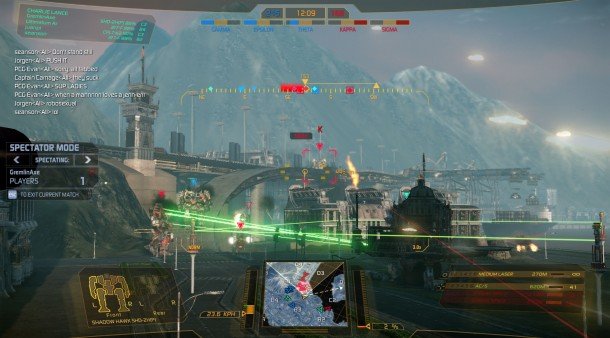
Though there's a lot of variation in mech pricing, MWO is more expensive than average free-to-play games. With the exception of “legendary” variants, all mechs are buyable with in-game currency (known as C-bills) or cash (MC). Mechs scale upward in price with tonnage, from 560 MC (about $2.60) for a tiny, 20-ton Locust, to 1,850 MC (about $8.50) for a 50-ton Centurion, all the way to 7500 MC (a ridiculous $31) for the 100-ton Atlas legendary variant. Most heavy and assault mechs range from 2,000 to 4,000 MC each, or $9-19. If you pay $50, expect to be able to buy five or seven mechs and a few custom colors to paint them with.
If you're saving every C-bill, earning enough to buy one mech on an unboosted account might take as few as 30 and as many as 60 matches. I appreciate that kills aren't exclusively the most profitable way to earn in-game currency, as this encourages teamwork a little more. But you do earn C-bills primarily based on your performance, and you'll get more for racking up kills, assists, support actions, and victories.
Piranha's work to modernize MechWarrior is admirable. MWO's layered mechanics facilitate intricate combat that's deep, balanced, and--most importantly--satisfying in your hands. That almost singular focus on combat design does leaves MWO slim on modes and tutorials as well as with some rough UI in key places like the MechLab, but not at the expense of this very entertaining foundation that happens to form a solid footing for the future.
Price: Free-to-play
Release date: Out now
Publisher: Infinite Game Publishing
Developer: Piranha Games
Multiplayer: 24 players
Link: http://mwomercs.com
ESRB: N/A
Slightly overpriced, but a more than worthy successor to one of PC gamings greatest franchises that nails the important part: combat.

Evan's a hardcore FPS enthusiast who joined PC Gamer way back in 2008. After an era spent publishing reviews, news, and cover features, he now oversees editorial operations for PC Gamer worldwide, including setting policy, training, and editing stories written by the wider team. His most-played FPSes are Hunt: Showdown, Team Fortress 2, Team Fortress Classic, Rainbow Six Siege, and Counter-Strike. His first multiplayer FPS was Quake 2, played on serial LAN in his uncle's basement, the ideal conditions for instilling a lifelong fondness for fragging.
